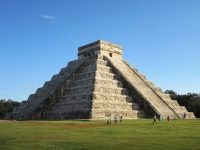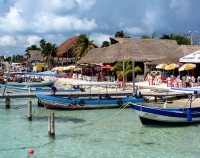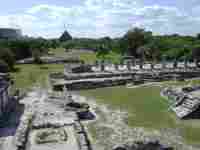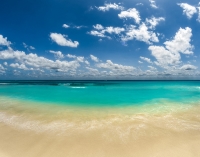Cancun Travel Guide
One of the most famous beach resort cities in the world, just mentioning Cancun conjures images of perfect white-sand beaches, colourful reefs, mysterious Mayan ruins and big parties. Although it is best known for all-inclusive package holidays offering all the glitz and glamour of upmarket beach hotels, complete with a wonderful variety of restaurants and many options for shopping, Cancun is also situated in the region once inhabited by the ancient Mayan people, which adds a seductive historical element to lounging on the beach.
Cancun is nestled on the northeastern tip of the Yucatan Peninsula, which entices travellers not only with its gorgeous coastline, but with relics of the proud ancient culture of the Mayans still strewn throughout the jungled peninsula. The destination is adored by sun, sea and sand fanatics for its incomparable beaches; by scuba divers and snorkellers for its colourful coral reefs; by young party animals for its enviable nightlife; and by adventurers seeking out what is left of the Mayan kingdom.
Best time to visit Cancun
Cancun's peak tourist season runs from December to April, when the weather is pleasant, storms are least likely, and the sea is generally calm. The Yucatan Peninsula can be hit by hurricanes between June and October, making this a period many prefer to avoid. Cancun is hot and beautiful year-round but those who prefer to avoid crowds should be wary of travelling during Spring Break (March), when hordes of teenagers descend on Cancun.
What to see in Cancun
-Marvel at the impressive Mayan site of Chichen Itza, once a thriving ancient centre.
-Visit the Museo Maya for some insight into the ancient history and art of the region.
-Lounge on the numerous stunning beaches that are Cancun's main attraction.
-Ferry across to Isla Mujeres for a day of sleepy island fun.
What to do in Cancun
-Take a boat or submarine ride from Playa Linda.
-Explore the fascinating Mayan ruins of San Miguelito.
-Enjoy a fun day with the family at Cancun's Wet n Wild waterpark.
-Go swimming with dolphins at Dolphinaris.
Beyond Cancun
The Yucatan Peninsula provides many attractions on Cancun's doorstep, including Mexico's biggest island, Cozumel, which is one of the best scuba diving destinations in the world. The Yucatan is also home to several other wildly beautiful beach resorts including Playa del Carmen and Puerto Costa Maya.
Getting there
International flights to Cancun land at Cancun International Airport, Mexico's second busiest airport, situated nine miles (17km) southwest of the hotel and resort area.
Did you know?
-Cancun generates about a third of Mexico's tourism revenue.
-The white sand of Cancun is made from crushed coral which resists the heat of the sun.
-Cancun boasts the second largest coral reef in the world, the Great Mayan Barrier Reef.
Things to do in Cancun
Unsurprisingly, the vast majority of Cancun's activities and attractions revolve around the coastline. The area is blessed with many beautiful beaches and the variety of watersports is somewhat overwhelming. Some scuba diving or snorkelling is a must as the underwater world is just as lovely as the white sands, and there are some gorgeous dive sites between Cancun and Isla Mujeres, where coral reefs abound. Exploring the Cancun Underwater Museum (MUSA) is an exciting adventure for divers. Other favourite water activities include swimming with dolphins (or even sharks!), visiting the water park, or taking an excursion to the sleepy paradise island of Isla Mujeres.
If tourists can manage to drag themselves off the stunning white-sand beaches and away from the plethora of fun water activities, Cancun has some cultural and historical diversions as well. The Museo Maya is an impressively large museum showcasing Mayan artefacts found in the region and providing some fascinating historical context for visitors to the peninsula. The San Miguelito Archaeological Site (in the museum grounds) and the El Rey Ruins are both intriguing examples of ancient Mayan remains in Cancun. The famous ancient site of Chichen Itza, with its impressive pyramids and mysterious jungle setting, is one of Mexico's greatest attractions and a must for visitors to Cancun.

Chichen Itza
Set in the jungle and said to have been inhabited for more than 2,000 years, Chichen Itza is the Yucatan's most visited ancient Mayan site. The main attractions at Chichen Itza are the Pyramid of Kukulkan (the plumed serpent god), and El Castillo, a grand pyramid topped by a temple that dominates the site and has been declared one of the Seven New Wonders of the World. Inside the pyramid is a smaller pyramid, the inner sanctum, containing one of the greatest finds on the site: the brilliant red jaguar throne with jade spots, inlaid eyes and real jaguar teeth. Another building of interest is El Caracol, an observatory with slits in the dome aligned with certain astronomical appearances at specific dates.

Isla Mujeres
The stunning Isla Mujeres is a short ferry ride away from the resort, and is known for its relaxing atmosphere and slow island pace. Popular activities include lounging on the pretty beaches (particularly those on the north and west sides of the island), swimming with sharks and dolphins, deep-sea fishing, and kayaking. Divers should absolutely make a point of exploring the remarkable Underwater Sculpture Museum.
The project was set up in 2009 to create an artificial reef after the Cancun and Isla Mujeres areas had suffered storm damage, and will eventually help new coral reefs to form. Six artists from Mexico and Britain put this unique collection together, spreading the more than 500 sculptures across two underwater galleries at depths of between 9,8ft (3m) and 19,6ft (6m). The display encompasses human figures in a number of poses, and a variety of guided snorkelling and diving tours are available. Visitors can also view the collection from the comfort of a glass-bottom tour boat.
There are excellent restaurants in the Downtown area (El Centro), where the signature dish is freshly-caught, Tikin-Xic spice-coated fish. The fish is wrapped and roasted in a banana leaf.

Museo Maya
Cancun's superb archaeological museum has three large exhibition halls and about 350 Mayan artefacts, including carvings, pottery, weapons, as well as tools, ritual objects and burial masks. One of the highlights is the 14,000-year-old skeletal remains found in Tulum's underwater caves, which greets visitors as they arrive. The museum is enclosed by landscaped grounds and nestled within are some fascinating Mayan ruins, including a small pyramid. This site, called the San Miguelito Archaeological Site, is possibly the best part of a trip to the museum. The institution is new, modern and air-conditioned, and a visit can also be a welcome relief from the heat outside.

Cancun Beaches
Cancun is unbeatable when it comes to sun-lounging and clear blue ocean water, with the northern stretch of Mujeres Bay including the popular Playa Langosta, Playa Las Perlas and Playa Tortugas, all of which are great for watersports, bars and restaurants. Playa Linda is a launching point for boat and dive tours, while Playa Caracol and Punta Cancun are excellent for family fun.
East side beaches are breezier with rougher surf. Chac Mool, Playa Marlin, Gaviota Azul and Playa Ballenas are ideal for parasailing and windsurfing; Punta Nizuc and Playa Delfines are perfect for a day of sand and surf. The best dive sites lie between Cancun and Isla Mujeres, at the colourful reefs of El Tunel, Grampin, Chuchos and Largo. The Cancun Underwater Museum (MUSA) is also a fantastic option for divers.
Eating Out
Mexican cuisine is recognised as one of the three most popular food styles in the world and Cancun is as good a place as any to sample authentic Mexican meals. Foodies should note that Cancun lies on the The Yucatan Peninsula, where the delectable local cuisine has a heavy Mayan influence, but also quotes from European (Spanish, Dutch), Caribbean, North African, and Middle Eastern (Lebanese) traditions. Must-try dishes include Sopa de lima (a spicy, flavourful chicken and tomato soup), and Salbute (deep-fried tortillas topped with chicken, turkey, lime juice, tomatoes, lettuce, avocados, and red onions). Yucatan food is often less spicy than the fare from other regions in Mexico, so it's a good option for foreigners with sensitive palettes. However, it's almost always accompanied by a salsa with a chilli base.
Seafood restaurants dominate in Cancun, which should be no surprise considering the quality and quantity of fresh seafood in the region. Popular seafood dishes include a variety of lobster specialities and ceviche (a kind of raw seafood salad). For fine dining there are many upmarket restaurants. Some of the most highly acclaimed can be found in the Ritz Carlton Cancun Hotel and in the Fiesta Americana Gran Coral Beach Hotel. In downtown Cancun there are some hidden gems and the far cheaper dishes found where the locals eat are often the best authentically Mexican options visitors can find in the city. Tulum Avenue and Yaxchilan Avenue have some of the best restaurants.
Shopping
The vast variety of shopping opportunities in Cancun ranges from modern malls and designer stores to open-air markets and the trays of insistent street vendors. It's a city built on tourism, so shops invariably accept credit cards and the opening hours tend to run from about 10am to 7pm during the week, and all morning on weekends.
Silver jewellery, traditional wooden statues (Alebrije), pottery, and fleece or cotton blankets are all popular souvenirs from Cancun, but visitors should ensure they don't buy anything containing black coral. The species is endangered and protected, and possesion of it could land visitors in some trouble at the airport.
Within the glitzy Hotel Zone, the Plaza la Fiesta is a popular shopping venue, and the El Zocalo bazaar is a great option for locally-produced arts and crafts. The main shopping strip of Paseo Kukulkan is lined with shops and souvenir stalls selling all the usual tourist trinkets and a few unexpected treasures. The Hotel Zone offers great quality and variety but the shopping experience can be somewhat soulless, as the stores tend to be international and there is little authentic local flavour on offer.
Mainland Cancun, commonly called 'downtown', is less glamorous but much more affordable. Yaxchilan Avenue is a good place to start, and the market on Tulum Avenue is wonderful for those seeking out local crafts, particularly silverware. Travellers will be expected to bargain in the local markets.
Nightlife
Cancun is celebrated for its rollicking nightlife and there are bars, lounges, live music venues and dance clubs enough to keep even the most determined party animals entertained. The club scene is feisty and energetic, and tailored mainly to please the young Americans that flock to the resort. However, anybody who's game for foam parties, bikini contests and boat races (the drinking contest, not the watersport) will be well catered for. Familiar chains such as Hard Rock Cafe and Senor Frog's are safe favourites with the international crowd and have been going for many years. Organised party tours such as Cuncrawl and Party Hopper are a great way to sample the best of Cancun's party venues. Most clubs open around 10pm and the music pumps until sunrise or later in peak tourist season.
Those seeking out something more sophisticated, romantic or sedate will find numerous stylish bars and lounges. One of the best venues for cocktails is the Thai Lounge. Culture lovers should try their best to see a performance by the internationally-acclaimed Ballet Folklorico, which performs a variety of traditional and performing arts shows at various venues in Cancun.
Getting Around
Buses are the cheapest way to get around in Cancun. Intercity buses are available from the station on Avenida Tulum, including service to Playa del Carmen, Tulum, Merida, and Campeche.
Taxis are perhaps the most convenient transport, and tariffs are loosely based on a zone system. Fares should be agreed on upfront, and travellers should note that taxis located outside restaurants and hotels often charge higher rates. It is also important to know that only approved airport taxis are allowed to collect passengers from the airport.
Car and scooter rental are popular as well, though they're considered dangerous and only experienced drivers should attempt these options. They can also be stressful, as traffic is chaotic and police are quick to pull tourists over.
Cancun Climate and Weather
The Yucatan Peninsula, including Cancun, is the hottest and most tropical part of Mexico, especially from June to August when average highs peak at 93F (34C). Low temperatures rarely drop below 68F (20C) and humidity tends to be high all year. Coastal breezes have a pleasant cooling effect on hot days.
The rainy season runs from May to October and is characterised by late afternoon tropical showers that usually last for a short time only. Cancun lies within the Atlantic Hurricane Belt and the flat terrain makes the Yucatan Peninsula especially vulnerable to storms, particularly between June and October. In fact, big storms can affect Cancun at any time of year and they can be violent, though they're usually short-lived. On average April is the driest month and October is the wettest.
The peak tourist season in Cancun runs from December to April, when the weather is warm and the sea reliably calm, making it a good time for watersports and scuba diving. Out of this peak season, prices at the resorts tend to drop dramatically and the peninsula is less crowded. Although the threat of hurricanes puts some travellers off, between June and October the weather can be wonderful (hot with cooling winds) and can be a great time to visit if no storms hit.
Mexico travel info
Electricity
The electrical current is 110 to 120 volts, 60Hz. Two-pin flat blade attachment plugs are standard.
Language
Spanish is the official language in Mexico. Some English is spoken in tourist regions.
Money
The local currency is the Mexican peso (MXN), which is divided into 100 centavos. Most international hotels and tourist facilities accept credit and debit cards, though visitors should take care as credit card fraud occurs. ATMs are available in most cities and towns, and are the most convenient way to get money. However, for safety reasons they should only be used during business hours and vigilance is advised. Travellers should carry cash if they're visiting rural areas. US dollars are widely accepted in holiday resort areas; foreign currency can be exchanged at one of many casas de cambio (exchange houses), which have longer hours and offer a quicker service than the banks.
Tipping
Waiters and bar staff should be tipped 10 to 15 percent if a service charge hasn't already been added to the bill. Tips of 15 to 20 percent are the norm at international resorts, including those in Los Cabos.
Health
Malaria and dengue fever occur in some rural areas but not on the Pacific and Gulf coasts; Zika is still a risk in Mexico. Travellers should consider a rabies vaccination as dogs and some wildlife such as bats carry the disease. It's best to follow sensible precautions regarding food and water, such as only eating foods that are cooked and served hot, and sticking to bottled water.
Medical facilities in major cities may be good, but are usually very limited or unavailable in rural areas. Comprehensive travel insurance is recommended. As medicines may be in short supply, travellers should consider taking prescription medications in their original packaging, accompanied by a signed and dated letter from a doctor detailing what the medications are and why they are needed.
Safety
Travellers should be cautious in big cities such as Mexico City, where crime can pose a risk for foreigners. In particular, women on their own should be vigilant and take care of their belongings, especially on public transport. It's best to only use authorised taxi services and to avoid bus travel at night.
Visitors are advised to be wary of people presenting themselves as police officers who attempt to fine or arrest them for no apparent reason, as these situations can lead to theft or assault. If in doubt, travellers should ask for identification.
Most of the violence related to drug cartel wars in Mexico is concentrated along the border between Mexico and the United States, with tourist zones generally unaffected. Hurricanes may affect the coastal areas between June and November.
Local customs
Mexicans are not impatient and do not appreciate impatience in others, so travellers should expect opening hours and public transport times to be flexible and laid back. Locals are also friendly and hospitable people who greatly appreciate courteous behaviour. Travellers should note that it's common for Mexicans to communicate closer than one arm's length from each other, and that it's not an attempt to be forward.
Doing business
Though many Mexican businessmen speak perfect English, Spanish is the official language of business in the country, so learning a few choice words and phrases will go a long way toward developing a relationship with local associates. Business etiquette in Mexico is marked by a combination of formality and friendliness.
It's very rare to hear the word 'no' being used in a direct or confrontational way (bald refusals are seen as rude), and it's best to use titles ('señhor' and 'señhora') until specifically instructed not to. However, foreigners should not shrink away from engaging in personal discussions with their Mexican colleagues. Business meetings must be scheduled in advance, and then confirmed a few days before they are due to take place.
The dress code for the Mexican business world is smart and formal; business hours are generally from 9am to 6pm, Monday to Friday, with a two or three-hour siesta in the early afternoon.
Duty free
Travellers to Mexico who are over 18 years of age do not have to pay duty on 200 cigarettes or 25 cigars or 200g tobacco; 3 litres spirits or 6 litres wine. Other goods to the value of US$500 for those arriving by air, or US$300 for those arriving by land are premitted without incurring duty fees. Prohibited goods include narcotics, firearms and used clothing that is not part of a traveller's personal luggage. The export of archaeological artefacts is strictly forbidden.
Communications
The international access code for Mexico is +52. Travellers can purchase local prepaid SIM cards for unlocked phones or use eSIMs if their cellular providers support it on their networks. Hotels, cafes and restaurants offering free WiFi are widely available.
Passport & Visa
All foreign passengers to Mexico must hold a Mexico Visitor's Permit (FMM), which is issued free of charge, and obtainable from airlines, Mexican Consulates, Mexican international airports, and border crossing points. As part of the Western Hemisphere Travel Initiative (WHTI), all travellers transiting through the United States are required to present a passport or other valid travel documents to enter or re-enter the United States. Foreign passengers to Mexico should ensure that their passports and other travel documents are in good condition, as even slightly torn passports will not be accepted. It is highly recommended that travellers' passports have at least six months' validity remaining after the intended date of departure from their travel destination. Immigration officials often apply different rules to those stated by travel agents and official sources.
Entry requirements
US citizens must have a passport that is valid at the time of entry. A visa is not required for stays of up to 180 days but travellers need to complete an immigration form and have this with them when they enter and leave Mexico.
British citizens must have a passport that is valid for the expected duration of their stay in Mexico. A visa is not required for stays of up to 180 days but travellers need to complete an immigration form and have this with them when they enter and leave Mexico.
Canadian citizens must have a passport that is valid for the expected duration of their stay in Mexico. A visa is not required for stays of up to 180 days but travellers need to complete an immigration form and have this with them when they enter and leave Mexico.
Australian US must have a passport that is valid for the expected duration of their stay in Mexico. A visa is not required for stays of up to 180 days but travellers need to complete an immigration form and have this with them when they enter and leave Mexico.
South African citizens must have a passport that is valid upon their arrival in Mexico. A visa is required. Passengers with a valid visa issued by Canada, Japan, USA, United Kingdom or a Schengen Member State are visa exempt for a maximum stay of 180 days.
Irish citizens must have a passport that is valid for the expected duration of their stay in Mexico. A visa is not required for stays of up to 180 days but travellers need to complete an immigration form and have this with them when they enter and leave Mexico.
New Zealand citizens must have a passport that is valid for the expected duration of their stay in Mexico. A visa is not required for stays of up to 180 days but travellers need to complete an immigration form and have this with them when they enter and leave Mexico.
Useful contacts
Mexico Tourism Board: +52 55 5278 4200 or www.visitmexico.com
911 (General Emergency Hotline)Embassies / consulates in other countries
Mexican Embassy, Washington DC, United States: +1 202 728 1600.
Mexican Embassy, London, United Kingdom: +44 20 7499 8586.
Mexican Embassy, Ottawa, Canada: +1 613 233 8988.
Mexican Embassy, Canberra, Australia: +61 2 6273 3963.
Mexican Embassy, Pretoria, South Africa: +27 12 460 1004.
Mexican Embassy, Dublin, Ireland: +353 1 667 3105.
Mexican Embassy, Wellington, New Zealand: +64 4 472 0555.
Embassies / consulates in Mexico
United States Embassy, Mexico City: +52 55 5080 2000.
British Embassy, Mexico City: +52 55 1670 3200.
Canadian Embassy, Mexico City: +52 55 5724 7900.
Australian Embassy, Mexico City: +52 55 1101 2200.
South African Embassy, Mexico City: +52 55 1100 4970.
Irish Embassy, Mexico City: +52 55 5520 5803.
New Zealand Embassy, Mexico City: +52 55 5283 9460.



